|
There are a couple of interesting moments in the first ten minutes of The Thief of Bagdad (subtitled An Arabian Nights Fantasy, and yes, there's no 'H' in the name of the city here) that mark it as a film that is not of our time, and I'm not talking about the aesthetics here. The first comes in the shape of the religious quote used to open this adventure, which is not from the Bible but from the Koran. Appropriate to the setting without a doubt, but it's hard to imagine such a textual introduction to a modern Hollywood blockbuster, unless it was intended as a portent of things to come. The second occurs a while later when the titular thief, a cheerful rogue named Ahmed (played with gusto by Douglas Fairbanks), smilingly assures a Holy Man and his startled companions that "Paradise is a fool's dream and Allah is a myth." Put that in a mainstream film these days and the actor who delivered the line would probably find themselves the target of a fatwa, a barbaric weapon wielded by the religiously intolerant against those who dare to publicly challenge even the smallest aspect of their narrow beliefs. Hmm. That's me sorted, I guess. As it happens, Ahmed later turns to this very same Holy Man for guidance, so it all balances out. And as Holy men go, this guy's as helpful a dude as you could ever hope to encounter. I'll get to him in a minute.
Despite being one of the most lavish productions of its day and being greeted by almost universally enthusiastic reviews, this version of The Thief of Bagdad is today far less widely known and seen today than the 1940 remake produced by Alexander Korda and directed by a sextet of notable filmmakers (three of whom were uncredited on the film itself). This was certainly my first exposure to the film, and one that had me grinning broadly with delight through and just occasionally bouncing around in my seat and cheering. It may not have the vibrant colour palette of the Korda version (it's tinted monochrome, for heaven's sake), and may also play to that mid-period silent cinema convention of covering most scenes in non-angular wide and mid-shot only, but in all other respects it's every bit as enjoyable and inventive as its justly acclaimed remake.
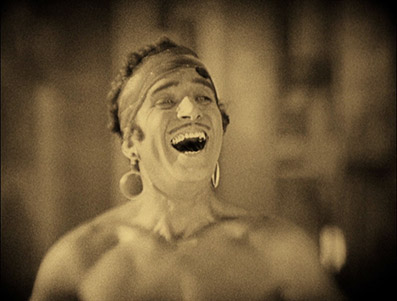
The guiding force here was Douglas Fairbanks, an actor whose work I am nowhere near as familiar with as I should be. When I sat down to watch the film for the first time I was certainly aware of his iconic status and his role in the formation of United Artists, but had actually seen almost none of his films. What an introduction! Here Fairbanks was not only the film's star, but its producer and its artistic guiding force. It was he who selected up-and-coming director Raoul Walsh, young production designer William Cameron Menzies, associate artist Anton Grot and others, all of whom would go on to have prestigious careers in their own right (Menzies was also one of those uncredited directors on the 1940 film adaptation of the story). Indeed, even back in 1924, The Thief of Bagdad was widely regarded as a Douglas Fairbanks rather than a Raoul Walsh film.
The first half-hour is all about establishing Ahmed as an immensely likeable rogue, a perennially cheerful criminal in a city that could clearly benefit from a little upbeat criminality. Ahmed enjoys every aspect of his chosen profession and delights in liberating just about anything from its rightful owner. When another thief is publicly flogged for stealing a ring, Ahmed responds by promptly nabbing it back from the man who ordered this unpleasant punishment, and when he first sees the Indian rope trick demonstrated, he is delighted less by the trick itself than the idea that he could use it to break into buildings with higher walls than he would otherwise be able to scale.
Assisted by a grizzled associate (played by comedic actor Snitz Edwards), whose sole purpose seems to be to disguise himself as a pot (you need to see this to get it), he uses the rope to secretly enter the palace of the local Caliph (Brandon Hurst). There are spoils aplenty here, but once he claps eyes on the sleeping but oddly nameless Princess (Julanne Johnston) he has an altogether different prize in mind. Escaping the palace by the skin of his teeth after being discovered by the Princess's Mongol slave (the lovely Anna May Wong, whose career was effectively launched by this film), he takes only the Princess's golden slipper with him. His associate is just a little dismayed by this paltry prize. "Nizzy noodle!" he says to no-one in particular, "He's turned love bird."
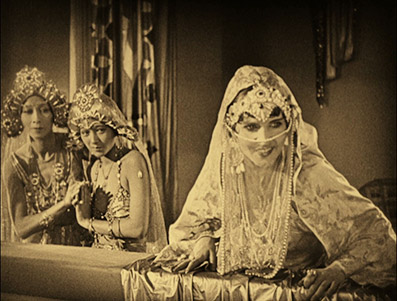
The following day is the Princess's birthday, and royal suitors have come from the East to seek her hand in marriage. The Princess herself is far from keen on the trio of contestants that enter the palace – the Prince of the Indies (African-American actor Noble Johnson) spends all his time scowling, the Prince of Persia (who is actually played by actress Mathilde Comont – I'd never have realised had the commentary not informed me) is the size of a buffalo and quite unlike his later computer game character, and the Prince of the Mongols (Japanese actor Kamiyama Sôjin) is all oriental and scary and chills her to the bone. But what's this? There's an unexpected fourth suitor, one with the grand title of Prince of the Isles, of the Seas, and the Seven Palaces. Of course it's Ahmed, who with the help of his associate has nicked all of the necessary regal attire to successfully pass himself off as a young prince from lands afar. The Princess really likes him. Mind you, as Fairbanks rides into court, a beaming smile on his face and his muscular torso flatteringly framed by a silk shirt, he looks so effortlessly gorgeous that even I started to fancy him.
It's about here that we have our suspicions confirmed about the Mongol slave when she tells the Mongol Prince that it has been prophesised that the Princess will marry whoever is first to touch a rose from the tree in her garden. When the Prince moves to act on this surreptitiously delivered information, however, a series chance events triggered by a single bee land Ahmed squarely in the centre of the tree instead. When Ahmed climbs up to the Princess's room, the two hit it off immediately and the she thus selects him as her future husband. Their future happiness would seem to be sealed, but there's just one problem – despite his deception, Ahmed is not a prince but a lowly thief and he knows it, and thanks to the Mongol slave he had the run-in with when he broke into the palace the night before, soon everyone else is aware of it too. The Caliph orders him to be flogged and then torn apart by an ape, but the Princess has fallen head over heels for him and bribes the guards to smuggle him safely out of the palace.
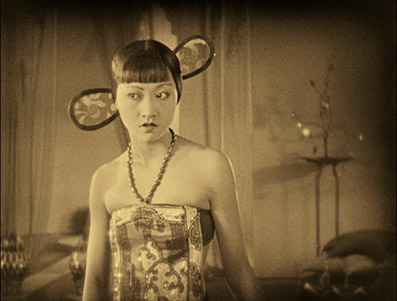
Forced to choose another husband from the unsavoury trio, the Princess sets them all a quest, to travel to lands afar and return after seven moons with the rarest treasure they can find. Ever the evil bugger, the Mongol Prince hedges his bets by sending spies after his rivals and ordering his Counsellor (K. Nambu) to smuggle an army into Bagdad in his absence in order that he may take the city and get the girl, whatever the outcome of the challenge. The dejected Ahmed, meanwhile, visits the above mentioned Holy Man, who not only advises him, but provides him with specific instructions about where he should go to find a prize that will outshine anything his rivals might discover on their travels. Man, if this guy were at our local church or mosque, we'd be there every week chanting prayers and asking him for favours.
It's here that the fantasy adventure tale we all know from the Arabian Nights stories really gets under way, as Ahmed is set a series of quests of the sort that would one day constitute a solid base for a computer-based adventure game. He dances around fire, battles giant monsters, and retrieves a key from the bottom of the ocean, where a trio of attractive sirens put his devotion to the Princess to a serious test. It's also the second half of the film in which the more famous iconography of the Arabian Nights tales is featured, which include a magic carpet, an all-seeing crystal, a winged flying horse, and a cloak of invisibility, all of which are put to solid narrative use.
The Thief of Bagdad is a spectacle of the old school, where gargantuan sets had to be physically constructed and huge crowd scenes required the recruitment and costuming of a small army of extras. Knowing this in an age when both can be created on a computer and matted it after the fact at a fraction of the budget actually makes the logistics of such an achievement seem all the more impressive. There's no doubt that this affects the filmmaking itself, repeatedly pushing the camera away from the human subjects in order that we may better appreciate the scale and extravagance of their surroundings. Close-ups are rare and restricted mainly to inanimate objects, and camera moves are largely limited to the occasional side-on track with characters as they walk, run or ride.
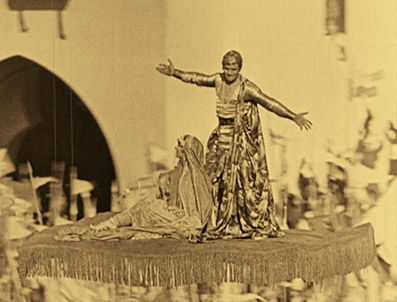
None of this should be taken as criticism. This was very much the filmmaking style of the time, and while Walsh and Fairbanks may lack the sheer inventiveness and chance-taking of silent-era Murnau or Lang or the cross-cutting dazzle of D.W. Griffith, the film's engagement with its characters is never less than total. As the story's leading man, Fairbanks' perennial cheer and exuberant physicality prove disarmingly seductive and align us to Ahmed from the moment he first appears on screen. Low key his performance is not, but while Fairbanks may frequently be playing to the gallery, he's clearly fully aware of that fact and having fun with the convention of silent movie over-expressiveness. Intermittently this is put to surprisingly effective storytelling use, as when he mimes his plan to kidnap the Princess with a drugged flower, which he does quickly and clearly enough to require no secondary explanation. The big surprise, though, is the level of subtlety at work elsewhere, most notably in the Mongol camp, with Kamiyama Sôjin, K. Nambu and particularly Anna May Wong all delivering performances that at times border on the naturalistic. In their own quiet way they occasionally come close to stealing Fairbanks' thunder.
The special effects, which are largely confined to the incident-packed second half and credited to the one-time-only team of Hampton Del Ruth and Coy Watson Sr., are superbly executed. The optical work (which was all done in camera) is consistently impressive, from the small tornado that accompanies Ahmed's movements when wearing the cloak of invisibility to the army he creates for the final showdown, a simple enough effect that nonetheless dazzles in its scale. But it's the mechanical effects that really catch your eye. The magic carpet is probably the star of the show here; from its beautifully handled first take-off to its super-smooth landing on the palace steps, it moves with the grace and physicality of a real flying object rather than a matted-on overlay, and in this respect has the edge on its optically composited successor in the Korda version. And as inventive solutions go, the film really scores in the conviction of its underwater scene, created by lowering Fairbanks down on (invisible) piano wires and shooting in slow motion, a technique rarely employed by the cinema of this period.
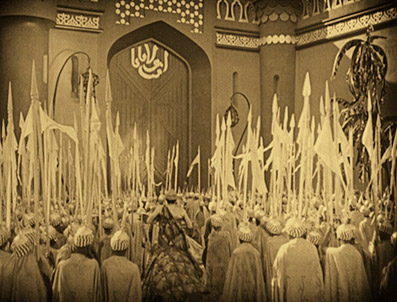
The Thief of Bagdad is a rousing and hugely enjoyable fantasy-adventure realised on an epic scale, one whose get-the-girl-at-all-costs love story I became utterly caught up in from an early stage. I'm not kidding here – after Ahmed has admitted the truth to the Princess and has returned the ring that she used to select her future husband, when she places it back in his hand I actually let out a small cheer. It's old school Hollywood storytelling from an era when happy endings were the order of the day and we didn't feel cheated by them, and when movie stars shone so brightly that they illuminated the films in which they appeared and fired up the talents of those who worked at their side.
Not quite sharp enough to cut your eyeballs on, perhaps, but the transfer here is still quite something to behold for a film made back in 1924. What immediately strikes you is how clean the image is – dust spots are very rare and scratches and other damage have largely been cleaned up or toned down to the point where you hardly notice them, and when they do become more visible it's only for a few seconds. The image has also been stabilised to the point where there is hardly any movement within the 1.33:1 frame, and while a few missing frames here and there do cause some occasional small jumps in character movement, the instances are minimal. The level of detail is generally impressive for a film of this vintage, and really shines on some of the character mid-shots of the more expansive wide shots of the sets or those involving large crowds of people. The colour tinting is subtly done and lends the visuals a poetic quality that you just know a straight monochrome print would lack.
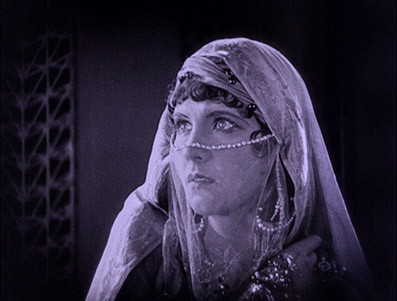
On the commentary track, Fairbanks' biographer Jeffrey Vance admits that of all of the scores he has heard accompanying the film, this one is his favourite, and it's not hard to see why. Composed by Carl Davis, played by the London Philharmonic Orchestra and inspired by the music of Nikolai Rimsky-Korsakov, this really is a magnificent score, a full-blooded orchestral adventure tale in musical form, one that compliments and enriches the action and the drama. I could easily imagine paying to hear this performed live at the Royal Albert Hall, and have run the disc once when working just to have this music playing in the background (unfortunately I kept getting distracted by the irresistible urge to look up at dramatic moments). You can listen to it either in Linear PCM stereo or DTS-HD Master Audio – both sound terrific, but the DTS track feels a little more widely spread and has a tad more oomph on the bass notes.
Fairbanks and Fantasy (17:09)
A video essay by Fairbanks biographer Jeffrey Vance that "draws upon a wealth of production photography and imagery to illuminate the making of The Thief of Bagdad," which is complimented by textual information and a music score that I was never quite comfortable with. There's plenty of interesting stuff here, and that photo archive really is littered with goodies, and all the images are in excellent condition. It's also here that I learned about the game Fairbanks invented and patented, a combination of tennis and badminton that he modestly named 'Doug'.
Commentary
Here Jeffrey Vance gets off to a slightly worrying start by assuring us that he doesn't want to reveal too much about how some of the effects in the film were achieved as he doesn't want to destroy the magic. This actually turns out to be largely hyperbole, as despite a few brief dead spots and a couple of instances of just describing what's happening on screen, this is a wonderfully detailed commentary that delivers a treasure chest of facts about the film and about Fairbanks, whose contribution to early cinema goes far, far beyond being a top-flight leading man. I'm not going to start making a list of the subjects covered here as it would go on for a couple of paragraphs at least – safe to say I was enthralled throughout and learned a huge amount about the film and its multi-talented star. A very fine extra feature.
Booklet
The key inclusion here is a solid essay on the film and the key personnel involved in its making by Laura Boyes of the North Carolina Museum of Art, which is complimented by some high quality stills, the key credits for the film and the usual notes on viewing, which hopefully none of you should need by now.
A hugely entertaining, old school fantasy-adventure done on the sort of scale that the big Hollywood studios tended to do best, and given exemplary treatment here by Masters of Cinema. There aren't many extra features, but all are first rate and taught me a huge amount about the film and it's remarkable producer-star. Terrific stuff, and highly recommended.
|